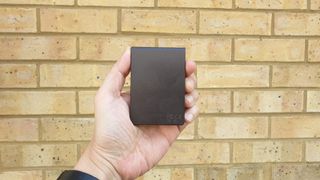I have a confession to make - I may have been a bit too harsh on a review I wrote three years ago. I gave a mere three star to the product I am now writing ecstatically about today.
The Lexar SL200, I wrote back then, was an, "OK product and that’s about it. Compared to almost everything else on the market, it lacks a clear edge and its premium pricing is not helping it at all."
Well, fast forward almost three years and the price of the 2TB version SL200 has been slashed by a staggering 70% since it launched back in June 2021, almost a year after my review. That alone means I should probably re-review the drive and add at least one star to the review.
At $89.99, it is the cheapest 2TB portable SSD right now anywhere. That is still far more expensive than a standard portable hard disk drive of similar capacity but let's not forget why an external SSD is a better long run solution for storing your data, files and folders.
✅ Faster It is one of the slowest external SSDs we've ever tested but it is still 3X quicker than most portable hard disk drives.
✅ Works with smartphones A little-advertised feature is that most of the newer portable SSDs have a native Type-C connector that can be plugged into any recent smartphones and be used as storage for your portable device.
✅ Sturdier Because there's no moving parts, the SL200 is a bit more ruggedized than any external consumer hard drives. It should survive a drop on a hard surface from a few feet unscathed.
✅ Smaller The SL200 is smaller than any 2.5-inch hard drive we've seen and by extension, smaller than any portable hard disk drives as well. For once, you can easily slide it in your rear jeans pocket.
✅ 3-year warranty Lexar offers a three-year warranty on its SSD which is 3x what the likes of Seagate and WD offer for portable hard disk drives. Again, that's down to the fact that mechanical parts fail more often than electronics.
Is a portable HDD slower than an external SSD?
Yes. I cannot think of any scenario where it wouldn't be the case and just to confirm, we're talking of portable hard drives (the ones that can be carried around, smaller cousins of desktop or external hard drives). Hard drives are slower because they are mechanical; the data is stored on physical platters and accessed via a head located on an arm; similar to a turntable reading vinyls.
Your average external HDD such as the Seagate Backup Plus has a throughput of 140MBps, that is, it can transfer data up to that speed. The slowest external SSDs we've tested would hit about 450MBps (and that's the SL200), which is about 3X the speed.
So a folder that take about three minutes to be transferred on a portable hard drive will take less than one minute on all but the slowest portable SSD.
Can an internal SSD be used as a portable SSD drive?
The answer is - unsurprisingly - yes. See an internal SSD is just a bunch of components inside a casing (either plastic or metal), an enclosure that actually protects the electronics inside. Protecting it with an outer case is therefore superfluous unless you want to physically hide the drive for whatever reason or want to make it look more aesthetic.
Just remember that they are no match for the best secure drives or the best rugged drives because they lack extra protection that will either prevent third parties from accessing the actual NAND chips or improve their imperviousness to harsh environments.
SATA SSD drives are the cheapest solid state drives so if you want the cheapest external SSD, you just need to take an internal SATA SSD and connect it to an external connector like the Sabrent EC-SSHD et voila! Even accounting for the cost of the latter (around $12), at the time of writing, you're looking at a saving of almost 20%. Every little helps.
The gap widens significantly the bigger the drive; An 8TB SSD costs about $430 (Samsung 870 QVO at Amazon) while a comparable portable model costs about $200 extra (VectoTech Rapid).
Note that you cannot do it with a PCIe NVMe internal SSD as its components are actually exposed. You will need to put the module into an external enclosure before being able to use it. They are not that expensive (about twice the price of the EC-SSHD) and have the benefit of using USB 3.2 Gen 2, which delivers speeds of up to 10Gbps, enough for the PCIe SSD which are usually faster than SATA SSDs.

